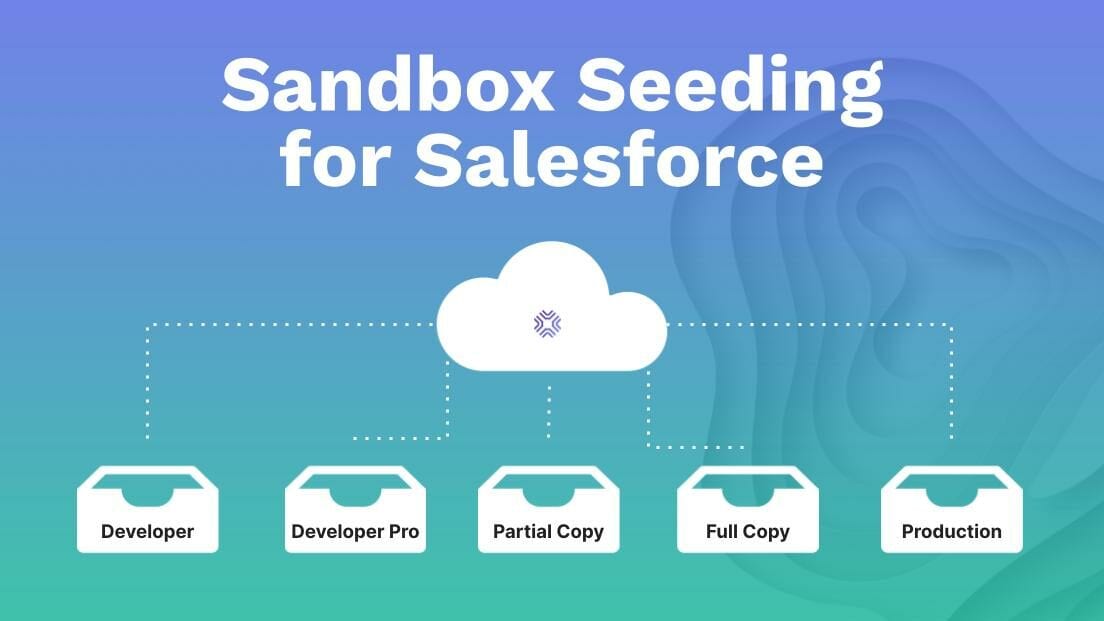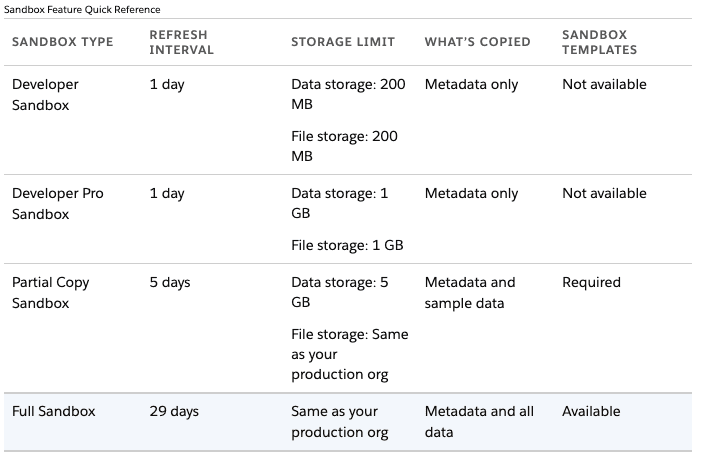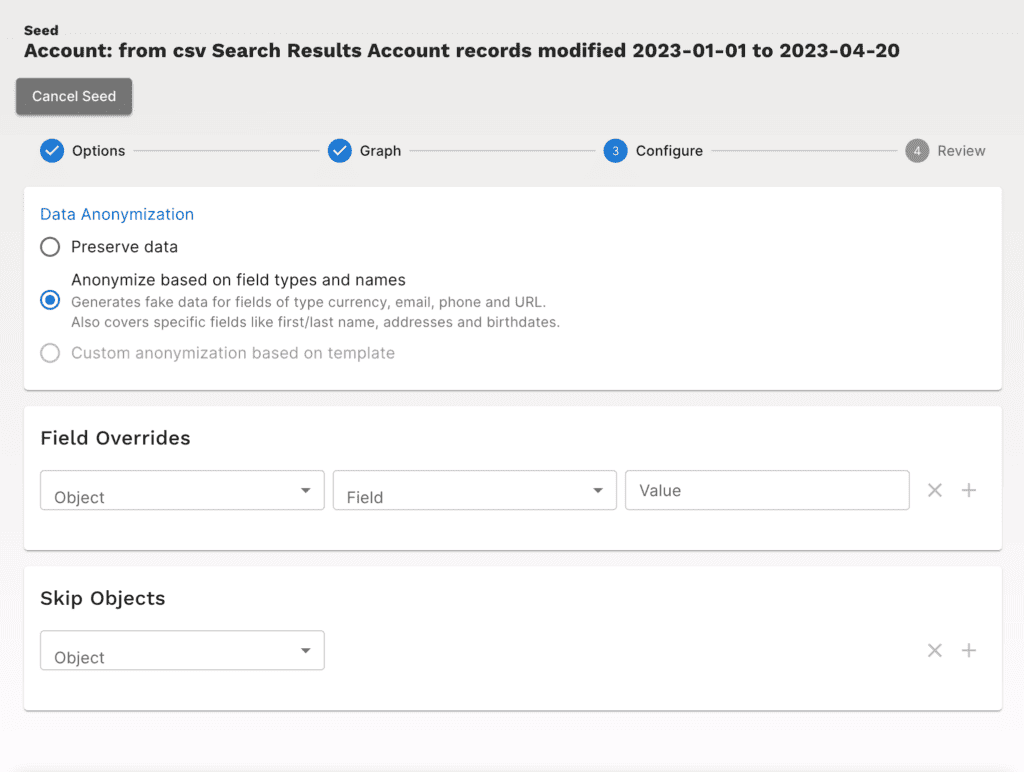GRAX Sandbox Seeding for Salesforce empowers customers to efficiently develop and test in realistic Salesforce environments with production data sets.
Salesforce is one of the most widely used cloud-based Customer Relationship Management (CRM) platforms, which allows organizations to manage customer data effectively. Salesforce is known for its robust customization capabilities, which makes it ideal for businesses of all sizes. However, making changes to a Salesforce environment can be a challenging and risky process. That’s where Salesforce sandbox seeding comes into play.
What is sandbox seeding?
Sandbox seeding is a process for developers looking to experiment with changes to their Salesforce environment without the risks associated with making changes to the live production environment. Essentially, sandbox seeding creates a replica of your Salesforce environment, allowing you to work on it without impacting your live data or processes. It’s the ultimate way to test new features, integrations, and customizations in a safe and isolated environment.
By copying data and metadata from your production environment to a sandbox environment, you can avoid any potential damage to your production data while testing new ideas. Sandbox seeding is an essential tool for ensuring that your Salesforce environment remains stable and error-free, so you can focus on growing your business.
Ready to maximize outcomes?
Try sandbox seeding for free.
Why do you need to use sandbox seeding for DevOps and testing?
Risk mitigation
Salesforce sandbox seeding helps mitigate the risk of changes being made directly into a production environment. Developers can simply test changes in a sandbox environment that closely replicates a real-world environment before pushing changes to the live environment. This allows for testing of new features, integrations, and customizations without affecting the existing data or live processes.
Enhanced collaboration
This functionality enables multiple developers to work on the same project simultaneously. With sandboxes, developers can share code, configurations, and data easily, which enables faster development and testing cycles, resulting in quicker deployment of changes.
Better testing
With the importance of CRM in daily business operations, comprehensive testing of changes are needed before being pushed to the production Salesforce environment. Developers can test the functionality of new features and integrations and identify any potential issues before deploying to the live environment. Testing in a sandbox environment ensures that the production environment remains stable and error-free.
Common Sandbox Seeding Challenges
Overall, there are many benefits to using sandbox seeding; however, it is not met without challenges. Businesses should be aware of these potential challenges and plan accordingly to ensure that they are properly leveraging the tool for their development and testing needs.

Challenge #1: Complexity
Creating and managing sandbox environments can be complex, especially for businesses with large amounts of data or complex integrations. It’s important to have a deep understanding of your Salesforce’s structure and functionality to effectively create test data sets and leverage sandbox seeding.
Challenge #2: Cost
While sandbox seeding can save money in the long run through the use of sandboxes, there are initial costs associated with the creation and maintenance of sandbox environments. Additional hardware or licenses may be required, which can add up over time, along with resource time to get everything stood up.
Challenge #3: Data management
Keeping sandbox environments up-to-date with the latest test data from the production environment can be time-consuming, especially if there are large amounts of data to transfer. To maintain accuracy, it’s important to ensure test data management so that testing is accurate and that sandbox environments are properly refreshed.
Challenge #4: Maintenance
Sandbox environments require ongoing maintenance to ensure that they are functioning correctly and have the latest updates. This can be a challenge for businesses without dedicated IT staff or Salesforce administrators.
Challenge #5: Data Security
Sandbox environments can contain sensitive or personally identifiable information (PII) customer information or intellectual property, so it’s crucial to ensure that sensitive data is secure and protected from unauthorized access or data breaches.

How can GRAX Sandbox Seeding help overcome these challenges?
At GRAX, we understand these challenges exist but we’re here to help with your Salesforce data management needs, including sandbox seeding. Our product and team of experts can help businesses navigate the complexities of sandbox seeding and ensure that their data is always available and protected.
Support for different environments
Depending on the type of Salesforce Edition your business has purchased will determine the number and types of sandbox instances available to your organization for use:

When using Salesforce sandboxes, it’s also crucial to remember that different types offer varied storage limits, refresh intervals, and other key considerations.

Luckily, GRAX Sandbox Seeding supports seeding into all of those types of environments:
- Developer Sandboxes,
- Developer Pro Sandboxes,
- Partial Copy Sandboxes,
- Full Sandboxes,
- And Production Instances.
This means that users do not have to worry about purchasing different environments to seed data with GRAX.
Data anonymization
Working with real customer data in sandbox environments, it’s critical to review the type of personal information included – confidential information or personal information, such as:
- Names,
- Addresses,
- payment details,
- And other personal data.
Anytime you use personally identifiable information, it can raise concerns about data privacy and security. This is why data anonymization is a critical component of sandbox data considerations.
There are a variety of data anonymization techniques, including data swapping, masking, or scrambling original data to prevent sensitive information from being exposed or breached. With GRAX, anonymizing sensitive data works by allowing users to generate synthetic data to replace real-world data with no direct link to the original dataset for safer testing and development.

By anonymizing data in sandbox environments, businesses can easily maintain data privacy and compliance while enabling effective development and testing in Salesforce environments.



